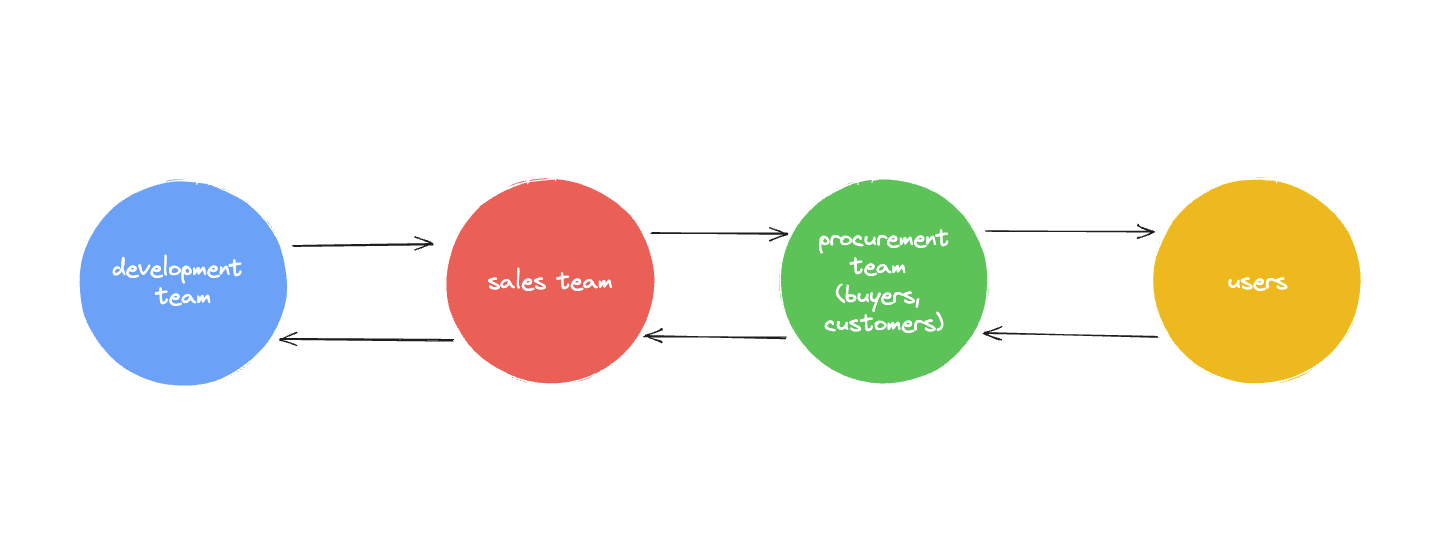Users, buyers, customers, consumers
In the world of product development, we often use multiple words to refer to the people that use our products. We have customers, we have users, we have buyers - these different words may at first seem like they refer to the same type of profile, but they’re not. It’s important to understand the distinction between these terms and be careful about how we refer to each of them. Even though it might seem trivial, sharing a common vocabulary it’s vital for clear communication. Company alignment and goals might be at stake.

As a starting example, let’s look at the difference between B2B and B2C companies.
In business-to-business (B2B), your company typically reaches out to another company, and some people from that company would act as the buyers. This is sometime a dedicated department or just an individual depending on the deal. They are the buyers, the ones who pay for your products or services. However, they are not necessarily the users of the products. For instance, if your company sells safety tools for construction workers, the buyers may be the procurement team of a construction company, while the users are the carpenters and masons who use the tools on a daily basis. The buyers approve the purchase because it’s important for the workers’ safety, but they themselves may never use the tools. This situation often creates a level of disconnect between the people using the product and the people buying it.
To further increase the disconnect there is often a significant gap between the people developing the product and the ones who buy it, creating communication challenges. The salespeople who sell the product to the customer are not the ones who develop it. Like the buyers of the product are not the ones who use it. This “telephone game” introduces a big challenge when it comes to gathering feedback and incorporating feature requests from customers. It becomes difficult to interpret these requests if there is no direct interaction between the users and the buyers.

Now, let’s talk about business-to-consumer (B2C) companies, where the lines between customers, users, and buyers are often more blurred. Take Duolingo, a language-learning app, as an example. When someone wants to learn a language, they buy Duolingo and become both the buyer and the user. The interaction in this case is much more direct and straightforward. As a result, feedback and communication between the makers and the buyers are clear and the incentives for making improvements are aligned. In B2C companies, there is often no intermediary sales team selling the product to customers, but rather a dedicated team focused on growth that works closely with the users and buyers. In other cases, customer success is often the team that is the most in contact to the users.
This faster interaction is often why working for consumer companies is more coveted, and why the pace of development is usually faster.
Of course, these are just two examples showcasing the different dynamics between customers, users, sales teams, and development teams. There are situations where buyers and users are the same, such as in B2C companies, and situations where they are not, such as in B2B companies. Additionally, there may be cases where the buyer and user are not the same in B2C. For instance, if the target market for a software product is children, the users are the kids, while the buyers might be their parents.
You see, you can get easily confused. It is essential to call a spade a spade, distinguishing between customers, users, buyers, and customers. Clear communication and easier decision making.
Words matter. It is crucial to use the right terminology to clearly understand the personas, incentives, and the complete value chain involved. By properly identifying and addressing customers as customers, and users as users, we can eliminate confusion and ensure effective communication and alignment throughout the product development process.